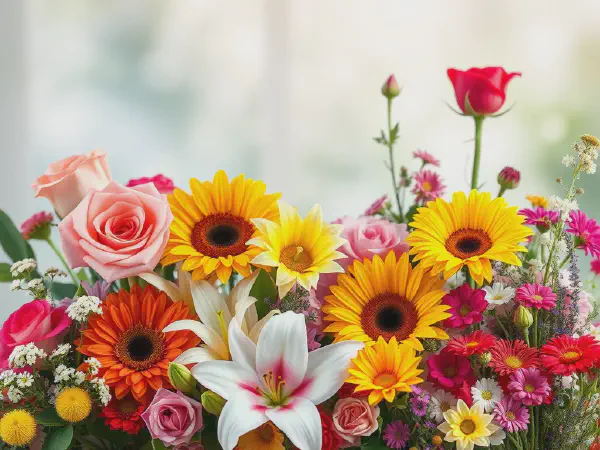Explore Different Types of Flowers for Every Occasion

Exploring the Diverse Types of Flowers
Flowers are one of nature's most beautiful creations, and they come in a plethora of varieties, each with unique characteristics, colors, and meanings. Understanding the different types of flowers can enhance our appreciation for nature and help us make informed choices for gardens, arrangements, and decorations.
In gardening and botany, flowers can be categorized into several types based on their lifecycle, habitat, and usage. The main categories include annual flowers, perennial flowers, wildflowers, tropical flowers, and edible flowers. Each type has distinct features that make them suitable for various climates and settings, adding beauty and functionality to our environments.
This article will delve into the various types of flowers, exploring their unique traits, care requirements, and the best ways to incorporate them into our lives. From the straightforward beauties of annuals to the hardy resilience of perennials, and the vibrant allure of tropical blooms to the delicate presence of edible flowers, there is a stunning variety available for all gardening enthusiasts and flower lovers alike.
As we journey through each type of flower, you'll learn about their distinct characteristics, ideal growing conditions, and special uses. Whether you're a seasoned gardener or a novice, understanding these types of flowers can inspire you to create stunning floral displays and cultivate beautiful gardens that flourish throughout the seasons.
Let's dive into the wonderful world of flowers and discover the characteristics, benefits, and care tips for each type of floral beauty!
Annual Flowers
Annual flowers are plants that complete their lifecycle in one growing season. They germinate, bloom, and produce seeds all within the span of a year, after which they die. This rapid lifecycle allows gardeners to enjoy a continuous display of color and blooms throughout a single season.
Some popular species of annual flowers include marigolds, petunias, zinnias, and snapdragons. These flowers are loved for their vibrant colors and ability to thrive in a variety of garden settings. They are often used in flower beds, borders, and container gardens.
Caring for annual flowers generally involves providing them with well-draining soil, regular watering, and ample sunlight. They benefit from deadheading, which encourages more blooms and helps maintain their appearance throughout the season.
The best placements for annual flowers often include sunny spots in gardens, patios, or window boxes where they can receive full sunlight and showcase their beauty. Grouping them in clusters enhances their visual impact, creating stunning displays of color.
Perennial Flowers
Perennial flowers are plants that live for more than two years, often returning year after year from their root systems. Unlike annuals, they may not bloom over the entire growing season but tend to have specific blooming periods, which can vary by species.
Benefits of growing perennial flowers include their longevity, lower maintenance once established, and their ability to attract pollinators such as bees and butterflies. Popular species include peonies, coneflowers, and hostas, each contributing unique textures and colors to garden landscapes.
Seasonal blooming of perennials can create a beautiful progression of flowers throughout the year, with some blooming in spring, summer, or fall. Planning a perennial garden with a variety of bloom times can ensure color and interest in the garden throughout multiple seasons.
Caring for perennial flower gardens involves ensuring good soil health, watering as necessary during dry spells, and dividing clumps every few years to encourage vigorous growth. Mulching can also help keep weeds at bay and maintain soil moisture.
Wildflowers
Wildflowers are native flowering plants that grow naturally in the wild without human intervention. They can be identified by their vibrant colors and unique shapes, often adapted to thrive in specific regions and conditions.
Many wildflowers, such as echinacea, black-eyed Susans, and lupines, have been found to possess medicinal properties. They are often used in herbal remedies, teas, and essential oils, showcasing the interconnectedness of nature and health.
Wildflower conservation efforts are essential for maintaining biodiversity and supporting ecosystems. Planting native wildflowers in home gardens can contribute to these efforts while providing habitat for pollinators and other wildlife.
Growing wildflowers in your garden can be both beautiful and environmentally friendly. Seed mixes for wildflowers are available, making it easy to create a natural look in garden beds, meadows, or along pathways, inviting nature into your space.
Tropical Flowers
Tropical flowers are renowned for their stunning and exotic appearance, thriving in warm, humid climates. These flowers often have vibrant colors, unique shapes, and rich fragrances, making them popular for decorative purposes.
Common tropical flower species include hibiscus, orchids, and birds of paradise. These flowers are often used in tropical-themed decor, special events, and floral arrangements, adding a touch of paradise wherever they are displayed.
Caring for tropical flower plants typically requires ensuring they receive enough humidity, warmth, and light. Since many thrive indoors, it's essential to provide the right environment with adequate watering and fertilization to encourage healthy growth.
Tropical flowers make for fantastic gifts due to their exotic appeal and ability to brighten any space. Their long-lasting blooms also make them an excellent choice for floral arrangements and special occasions, delivering beauty and joy to the recipient.
Edible Flowers
Edible flowers are not only aesthetically pleasing but also offer a unique culinary experience. Common types of edible flowers include nasturtiums, pansies, and calendula, each bringing distinct flavors and colors to dishes.
The nutritional benefits of edible flowers often include vitamins, antioxidants, and beneficial compounds. Incorporating them into meals can enhance both the taste and the presentation of various dishes, promoting a healthy diet.
Using edible flowers in recipes can elevate everyday meals, with options for garnishing salads, cakes, and drinks. They can also be infused in oils or syrups for added flavor and visual appeal.
Cultivating edible flowers at home is a rewarding endeavor, allowing gardeners to grow their own ingredients. They require similar care to other garden flowers, including proper sunlight, soil conditions, and regular watering, making them accessible to both beginner and experienced gardeners.
